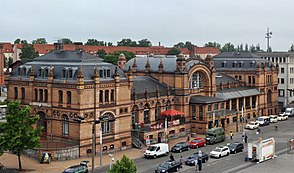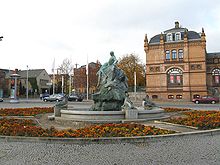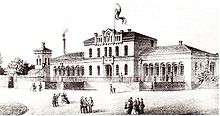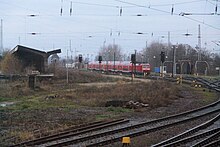Schwerin Central Station
| Schwerin Central Station | |
|---|---|
|
Reception building
|
|
| Data | |
| Location in the network | Separation station |
| Design | Through station |
| Platform tracks | 4th |
| abbreviation | WS |
| IBNR | 8010324 |
| Price range | 3 |
| opening | 1847 |
| Profile on Bahnhof.de | Schwerin_Hbf |
| location | |
| City / municipality | Schwerin |
| Place / district | Paulsstadt |
| country | Mecklenburg-Western Pomerania |
| Country | Germany |
| Coordinates | 53 ° 38 '4 " N , 11 ° 24' 29" E |
| Railway lines | |
|
|
| Railway stations in Mecklenburg-Western Pomerania | |
The main railway station in located in the district Paul City , northwest of the center of the Mecklenburg-Vorpommern state capital Schwerin . The station is designed as a through station and has four tracks on two platforms as well as a through track west of the fourth track and has been the station / Luisenplatz since 1847. The station is currently used by around 12,000 travelers every day.
building
The representative station building of the station was built in the years 1889–1890 according to designs by Ernst Moeller in historicist architecture using light-colored facing bricks for the facade. The main hall is connected to two corner pavilions by lower intermediate sections. The entrance hall was lowered in 1927. In the reception hall there is a Deutsche Bahn travel center and a few shops (bakeries, etc.). A pedestrian tunnel leads from the reception hall to the two platforms with a total of four platform tracks. On the opposite side of the station, the tunnel has two staircases and an elevator, which lead to the street Zum Bahnhof , from where the Platz der Freiheit can be reached. Previously, a separate pedestrian underpass fulfilled this connection function. However, due to the lack of elevators, this was not barrier-free and was filled in.
On the station forecourt is the ornamental fountain Rescue in Distress from 1910 with bronze sculptures by Hugo Berwald . The fountain was originally on the Schwerin market until 1927 .
history
Schwerin received its first rail connection in 1847 with the railway line to Hagenow . It was the oldest railway in Mecklenburg , which established a connection to the Hamburg – Berlin line. The line to Wismar was completed in 1848, the line to Rostock via Bad Kleinen in 1850. In 1888 there were connections to Crivitz (extended to Parchim in 1899) and Ludwigslust , and in 1898 the route to Rehna was opened.
Between 1889 and 1890, today's station building was erected in place of the previous building from 1847. The exterior of this building has remained largely unchanged since then. In the 1920s, the station tunnel was built to allow safe access to the platforms. From November 1976 the district town of Schwerin became the starting point of the city express to the capital of the GDR ( Berlin-Lichtenberg train station ). The ex 131/136 weever was with a cruising speed of 98 km / h the fastest train of its kind.
The name Grunthalplatz , as the name for the station forecourt, is based on a tragic event. Shortly before the end of the Second World War, Marianne Grunthal , who made a relieved statement at the news of Hitler's death, was hanged on a lamppost by SS guards. A memorial plaque was later attached to the mast.
After three and a half years of modernization, the station was officially reopened in December 2005. According to the railway, the measures, which were around 40 million euros expensive and were part of the German Unity No. 1 transport project , included the renewal of four kilometers of tracks, a bridge, platforms with roofs and modernization work in the building and in the underpasses, paying particular attention to the barrier-free access for wheelchair users was placed. Since 2005, the tunnel has led to access to the tracks to the rear of the former Reichsbahndirektion. The neighboring pedestrian tunnel was closed at the same time. Since then, a newly built electronic signal box has been controlled from the operations center in Berlin-Pankow. With the platform on track 3 and 4 extended to 370 meters, the length required for Intercity and Eurocity trains was achieved. By April 2006, there was still retail space in the entrance hall of the station and in the tunnel.
At the same time as the work, the city ensured that parts of Grunthalplatz were renewed. The bus station and the tram stop in front of the building have been structurally upgraded. These measures, which cost 1.2 million euros, were funded with 850,000 euros. Work is still being planned on Brunnenplatz and the train station entrance to the IntercityHotel . Especially for the Federal Garden Show 2009 , the train station should give visitors a good first impression of the city.
On September 18, 2008, the Pro Schiene Alliance named Schwerin Central Station “Station of the Year” in the “Cities with less than 100,000 inhabitants” category.
Transport links
In the 2014 timetable, Schwerin Central Station is located on the timetable routes 100 (Hamburg – Rostock), 152 (Rehna – Parchim) and 202 (Wismar – Cottbus).
The station is served by ICE and Intercity trains from DB Fernverkehr , as well as local trains from DB Regio Nordost and the East German Railway (ODEG).
Long-distance transport
| line | Line course | Tact | EVU | Vehicle material |
|---|---|---|---|---|
| ICE 26 | Stralsund - Rostock - Schwerin - Hamburg - Hanover - Frankfurt (Main) - Karlsruhe | Every two hours | DB long-distance transport | Series 411 / Series 415 |
|
ICE 30 / IC 30 |
Stralsund - Rostock - Schwerin - Hamburg - Bremen - Cologne - Stuttgart | Individual trains | DB long-distance transport | Series 411 / Series 415 /
BR 101 + InterCity car |
| IC 56 | Warnemünde - Rostock - Schwerin - Stendal - Magdeburg - Halle (Saale) - Leipzig | A pair of trains | DB long-distance transport | BR 101 + InterCity car |
Apart from the regular connections, individual trains connect Schwerin with:
- Bergen on Rügen , Ostseebad Binz , Greifswald (ICE 26, IC 30)
Regional traffic
| line | Line course | EVU | Tact | Vehicle material |
|---|---|---|---|---|
| RE 1 | Rostock - Bützow - Bad Kleinen - Schwerin - Hagenow Land - Büchen - Hamburg | DB Regio Nordost | Every two hours
(+ Amplifier in the peak season) |
Locomotive + double deck car (Dosto07) |
| RE 2 | Wismar - Bad Kleinen - Schwerin - Ludwigslust - Wittenberge - Berlin - Cottbus | East German Railway | Every two hours | Stadler KISS |
| RE 4 | Schwerin - Bad Kleinen - Grevesmühlen - Lübeck (one trip a day in each direction) | DB Regio Nordost | Individual services | Series 623 (LINT 41) |
| RB 13 | Rehna - Gadebusch - Schwerin - Crivitz - Parchim | East German Railway | Hourly | Series 650 |
| RB 17 | Wismar - Bad Kleinen - Schwerin - Ludwigslust | DB Regio Nordost | Every two hours | Series 442 (Talent 2) |
| RB 18 | Bad Kleinen - Schwerin | DB Regio Nordost | Every two hours |
The RE 1, RE 2 and RB 17 lines run every two hours. There are individual amplifier trains on the RE 1. The lines RE 2 and RB 17 overlap between Wismar and Ludwigslust at approximately hourly intervals. The RB 13 runs between Rehna and Parchim mostly every hour (exceptions are weekends and public holidays).
Connection to bus and tram
On the Grunthalplatz on the east side of the train station, there is a connection to the inner-city public transport via the tram and bus stop Hauptbahnhof . In addition to tram lines 1 and 4, bus lines 5, 7, 8, 10, 11 and 19 operated by Nahverkehr Schwerin GmbH , lines with connections to the surrounding area and long-distance bus lines (including to Berlin and Hamburg) also stop at the bus platforms . Its operation is carried out by Flixbus , as well as NAHBUS Nordwestmecklenburg GmbH and Verkehrsgesellschaft Ludwigslust-Parchim mbH (VLP) . There is also a taxi rank in the square.
There is a short walk to the west of the Platz der Freiheit , where tram line 2 and bus lines 10, 11, 12, 14 stop.
Former freight yard
The formerly independent freight yard in Schwerin northwest of the main station with its own signal box, its own general cargo loading and several freight sheds has meanwhile been downgraded to a station part of the main station and has since been completely abandoned. Some tracks are still used today as station tracks for the parking of passenger trains. This concerns bunk - pull trains of Hanse-Express (RE 1) and diesel railcars of DB Class 648 .
An urban planning competition was held for the subsequent use of the disused site. One and two-family houses as well as terraced houses are planned. The goods handling system and the signal box are to be retained and re-used.
Schwerin railway depot
The Mecklenburg Railway and Technology Museum with an extensive collection of museum vehicles (steam and diesel locomotives, passenger and freight wagons, narrow-gauge railway wagons) is housed in the former depot (Bw Schwerin), which is directly adjacent to the main station in a north-westerly direction.
See also
Web links
- Track plan of the Schwerin Hbf station on the Deutsche Bahn website (PDF; 161.2 kB)
- Overview of the Schwerin Hbf train station (PDF, www.bahnhof.de)
- Schwerin Hbf in 1986 - a private website for the replica of the Schwerin Hauptbahnhof
- Schwerin Railway Museum
Individual evidence
- ↑ Hahn, Polenz, Lösler, Schaeffer, Menzel: Architectural Guide GDR district of Schwerin. Berlin 1984.
- ^ NDR TV - Nordmagazin from September 18, 2008
- ↑ Schwerin freight yard becomes a new city quarter. (No longer available online.) DB Mobility Logistics AG, February 12, 2014, archived from the original on March 1, 2014 ; accessed on February 21, 2014 . Info: The archive link was inserted automatically and has not yet been checked. Please check the original and archive link according to the instructions and then remove this notice.







